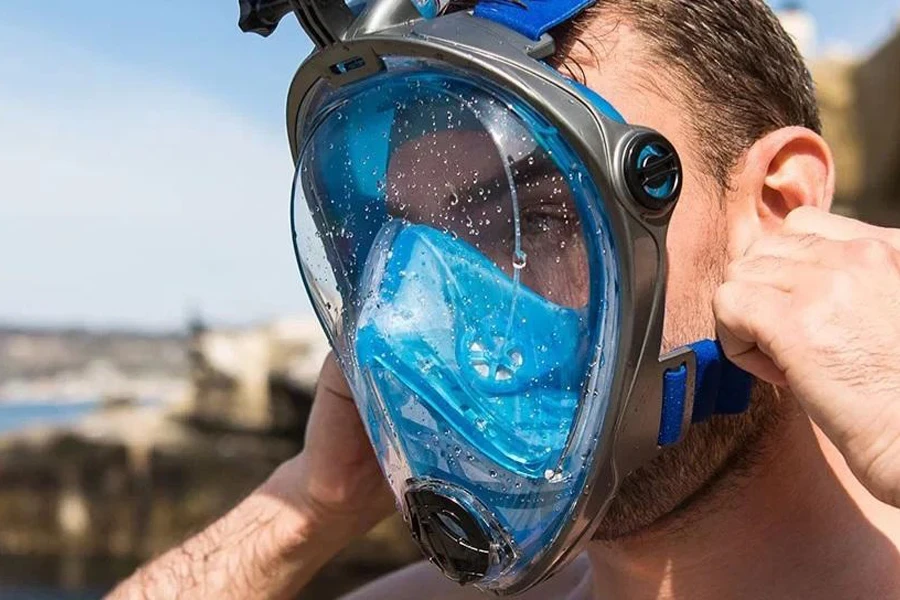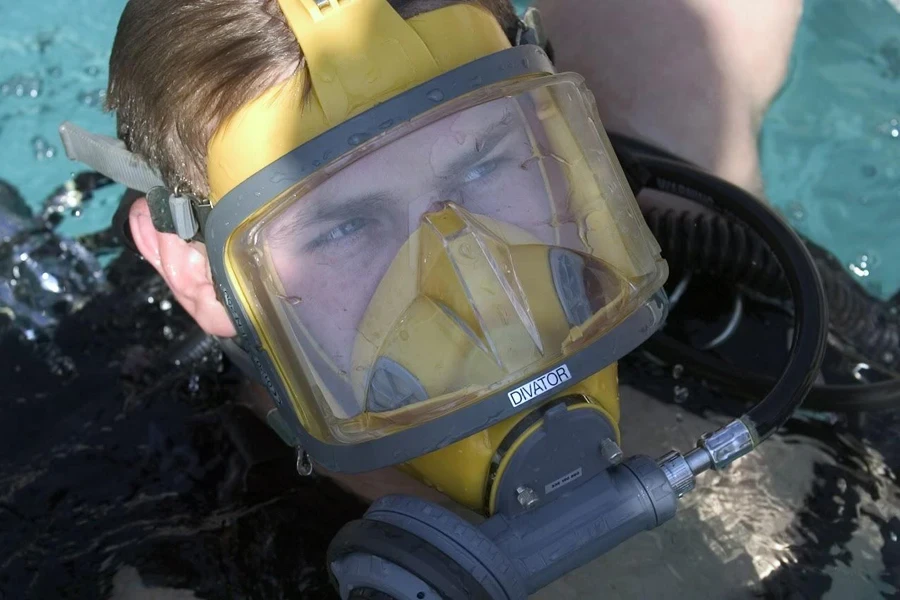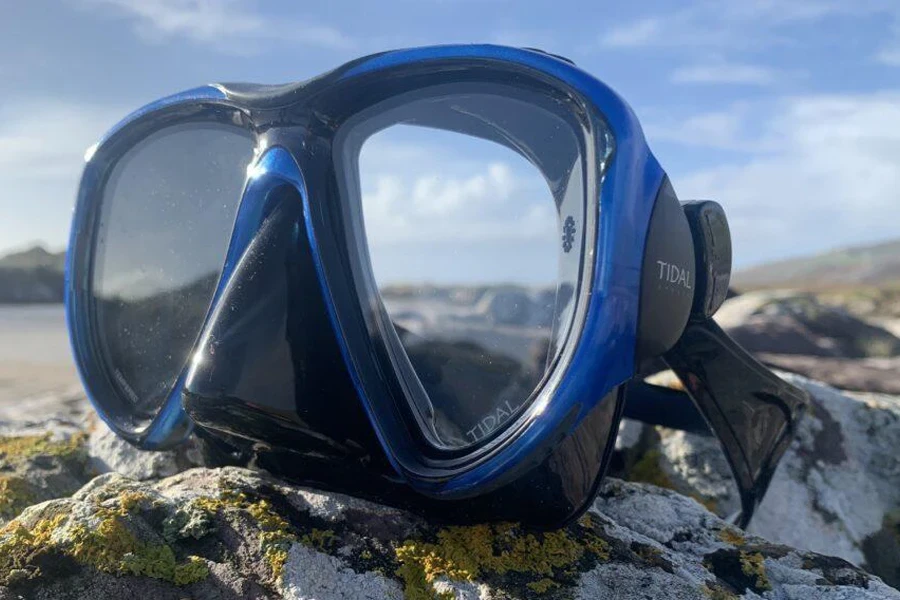Diving masks are the diver’s eyes when underwater, so it’s unsurprising that they are among the most important pieces of equipment to own. These masks allow consumers to see underwater marine life, hand signals, and gauge readings clearly when diving. Their critical importance means business buyers can’t afford to compromise when adding them to their inventories because a quality mask is essential for a successful dive.
Luckily, this article will explore every aspect retailers should consider when choosing diving masks to help avoid stocking the wrong ones. Also, it will provide tips to help businesses market their inventory successfully in 2024.
Table of Contents
How fast is the diving market growing?
Choosing profitable diving masks: What to consider
3 surefire marketing techniques to make more compelling diving mask offers
Final words
How fast is the diving market growing?
The diving equipment market has been increasing steadily in recent years. It was worth US$ 4.36 billion in 2023; reports expect it to reach US$ 4.75 billion in 2024 at a yearly 9.0% compound annual growth rate (CAGR). This growth is due to tourism, safety regulations, military use, and environmental concerns.
According to the same report, experts predict the market will grow strongly in the next few years. By 2028, they estimate it will be worth US$ 6.7 billion, growing at an 8.9% CAGR. Also, some major trends experts project to see more technology in the diving equipment market, more recreational diving, and a focus on sustainability/eco-friendly designs.
Choosing profitable diving masks: What to consider
Below are four key factors businesses should consider before purchasing diving masks.
1. Fit

When choosing dive masks, the most crucial factor is how they fit on the customer’s face. A good fit stops water from getting in, so divers won’t have to keep clearing their masks while diving. Faces differ, so business buyers must stock up on different mask types to cater to a wider range of customers.
Dive masks come in different shapes and sizes to fit various faces, heads, and noses. Here’s a table showing the options business buyers can add to their stock.
| Mask shape | Sizes | Face compatibility | Nose considerations | Other notes |
| Oval | Small, medium, and large | Wider faces and consumers with average facial features | Average nose pocket size | The most common and versatile shape |
| Round | Small, medium, and large | Rounder faces and customers with fuller cheeks | These masks can have smaller or larger nose pockets | Round masks are great for those who find oval masks too narrow |
| Teardrop | Usually one-size-fits-all | Narrower faces and those with smaller facial features | Smaller nose pocket | This mask offers good downward visibility |
| Rectangular | Small and medium | Wider faces with a longer distance between the eyes and nose | Ample nose pocket | Rectangular masks provide excellent side-to-side vision |
| Low volume | Usually one-size-fits-all | It can handle various faces but is better for smaller faces | Smaller nose pocket | It sits closer to the face, reducing the need to clear frequently |
2. Lens type

Single lens
Many divers believe that single-lens masks give a broader view. They have a single lens that spans the mask’s length, providing a wider field of vision. Additionally, these masks have comfortable fits due to their one-lens stretching around the nose area.
Single-lens masks are great for seeing all the sea life during dives. They are also handy for technical and cave diving. Whether customers want to explore coral reefs or deep underwater caves, this mask is the way to go.
Dual-lens
Most freedivers prefer dual-lens masks with two separate lenses. They often have teardrop shapes to help customers see downward better and a lower volume for easy clearance if they get flooded. Some dual-lens masks can also have corrective lenses. This feature is helpful for divers who wear glasses or don’t wear contacts, as it helps them see underwater clearly.
Tri-lens
Tri-lens diving masks are gaining popularity in diving. They have a single lens in the middle and clear windows on each side. This design reduces interference, increases peripheral vision, and gives a panoramic view. Their clear windows also help them see true colors and have better clarity underwater. Tri-lens masks also reduce blind spots while underwater.
Full face
As the name suggests, these masks cover the user’s whole face. Recreational divers usually don’t use full face masks, but professionals like commercial divers and videographers do. They are great for divers in cold water, as they also provide extra warmth. These masks allow experienced divers to talk to their partners using built-in intercom systems. They also have straps that help keep the mask in place, and divers don’t need to hold onto diving mouthpieces.
Note: Most recreational divers don’t need more than single or dual masks to enjoy their underwater time.
3. Skirt seal

The diving mask’s skirt makes a tight seal against the customer’s face. It’s super important because a good seal stops water from leaking into the mask. So, for the most attractive offers, go for skirts made of high-quality silicone for something more durable. They will also feel nicer against the wearer’s skin.
Most mask skirts are made of black or clear silicone. Clear silicone makes the mask look more transparent, but some divers prefer black. The color doesn’t affect how well customers can see underwater—it’s just a matter of personal preference.
Frame vs. frameless

Masks also come in framed and frameless designs. Consumers can easily disassemble framed masks for separate cleaning and replace broken parts if needed. They also offer a wide field of vision, around 150 degrees, and feature sturdy materials.
Contrarily, frameless masks are slowly taking over the industry because of their comfort and tight seal. Their straps attach directly to the skirt, allowing the mask to sit closer to the face. This design gives consumers a better underwater view.
3 proven marketing techniques to create more compelling diving mask offers
Strategy #1: Leverage the experiential element

Virtual “try-on”
Online business buyers must explore augmented reality (AR) features—if they want to boost their sales. For example, some e-commerce platforms like Shopify and BigCommerce allow customers to try on masks virtually using their phone cameras. By doing this, businesses can remove the guesswork around fit and style, motivating them to get the one that ticks all their boxes. Don’t forget to make the virtual try-on super user-friendly and use a catchy marketing message like “ See Yourself in Your New Mask—Try Before You Buy!”
The “fog test”
Nothing spoils a dive like foggy masks. So businesses with offline stores can set up demo stations (or offer online tutorials) to teach customers how to prep masks with anti-fog solutions and test for a secure seal. Confidence in a fog-free dive can largely help boost sales.
Sensory descriptions
Weave sensory details into product descriptions. Describe the sensation of a silicone skirt against the skin and the crystal-clear glass to engage the customer’s senses beyond sight. For example, a description like “feel the buttery-soft silicone against your skin” will let customers know they will get a comfortable and secure diving mask.
Businesses can also pair high-quality mask photos with captions like “Clarity so sharp, you can almost feel the cool water on your face.” The goal is to use catchy and empathetic phrases to get the prospective buyers in their feelings.
Strategy #2: Tap into diving communities

Run social media contests where divers share photos/videos of their mask woes with a specific hashtag. Here are clear guidelines to show businesses how to do it:
- Choose the hashtag. It should be something catchy like #MyMaskNightmare or #DiveUpgradeNeeded.
- Set clear rules on how to enter, deadlines, and what the prize is.
- Use a captivating marketing message to attract attention. Here’s a great example: “Mask Holding You Back? Share Your Dive Woes for a Chance to Win the Ultimate Upgrade!”
Strategy #3: Emphasize the value beyond the dive

Target snorkelers, too
Many diving mask features are perfect for casual snorkeling. So, retailers can broaden their marketing to include beach vacationers seeking an enhanced underwater experience.
Take the upsell angle
Sell masks alongside complementary gear. At a bundled discount, we offer “Dive Starter Kits,” which include masks, snorkels, fins, etc.
Masks as gifts
Remember the gift-giving market! Create guides or pairings for consumers looking for potential gifts. The titles should be interesting, like “The Perfect Gift for the Dive Enthusiast in Your Life.”
Bonus Tip: Consider a small aquarium/tank setup in-store with a few harmless fish if budget permits. Customers testing mask fit in-store can get a true underwater preview—which is memorable and compelling!
Final words
The perfect diving mask for everyone does not exist. Business buyers must consider the type of diving their consumers are doing, their experience, and other features that will give them the most comfortable experience.
People dive to enjoy some time underwater and learn something new, and the right diving mask will help them achieve that. According to Google data, 14,800 people search for diving masks monthly. So, stock up and use these tips to increase sales in 2024.
Discover more key insights and tips from other related sports topics when you subscribe to the Sports section of Alibaba Reads.




